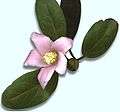Lagunaria
| Lagunaria | |
|---|---|
 | |
| Leaves and fruit | |
| Scientific classification | |
| Kingdom: | Plantae |
| (unranked): | Angiosperms |
| (unranked): | Eudicots |
| (unranked): | Rosids |
| Order: | Malvales |
| Family: | Malvaceae |
| Genus: | Lagunaria (DC.) Rchb. |
| Species: | L. patersonia |
| Binomial name | |
| Lagunaria patersonia (Andrews) G.Don. | |
| Synonyms[1] | |
| |
Lagunaria is a monotypic genus in the family Malvaceae. It is an Australian plant endemic to Lord Howe Island, Norfolk Island and parts of coastal Queensland. It has been introduced to many parts of the world. The genus was named for its resemblance to the earlier genus Laguna Cav., which was named in honour of Andrés Laguna, a Spanish botanist and a physician to Pope Julius III.
It now consists of the single species Lagunaria patersonia, commonly known as the pyramid tree, Norfolk Island hibiscus, Queensland white oak, sally wood,[2] or simply as White Oak on Norfolk Island.[3] It is however not a true Hibiscus, but does belong to the same plant family, Malvaceae. Its seed capsules are filled with irritating hairs giving rise to common names, itchy bomb tree,[4] and Cow Itch Tree. The "cow" part however appears to be a misnomer.
References
- ↑ "The Plant List: A Working List of All Plant Species". Retrieved 15 January 2015.
- ↑ "Australian Plant Names Index". Retrieved 14 January 2014.
- ↑ "Norfolk Island > Natural Environment > Flora". Australia Department of the Environment. Retrieved 2015-01-14.
- ↑ Tree Management Procedure For Trees On Public Land. Kiama Municipal Council. 2009.
Gallery
 Fruit of the Pyramid Tree
Fruit of the Pyramid Tree Flower of the Pyramid Tree
Flower of the Pyramid Tree
| Wikimedia Commons has media related to Lagunaria patersonia. |